JAPAN OMA MAGURO (TUNA)
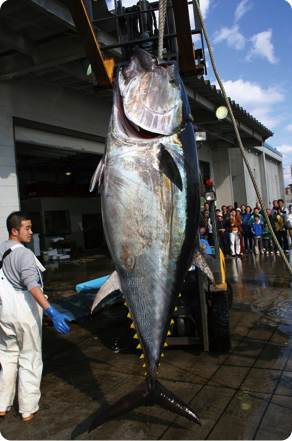
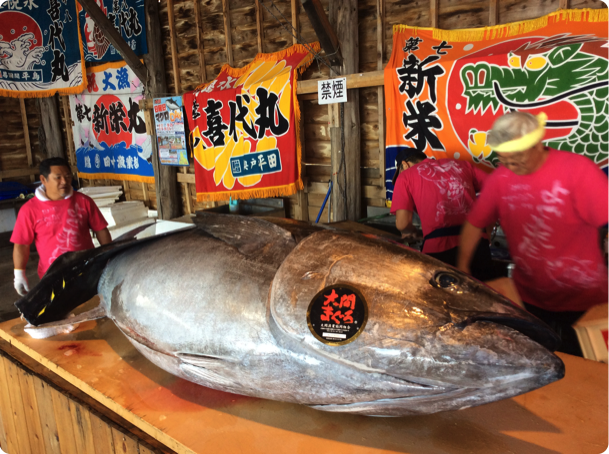
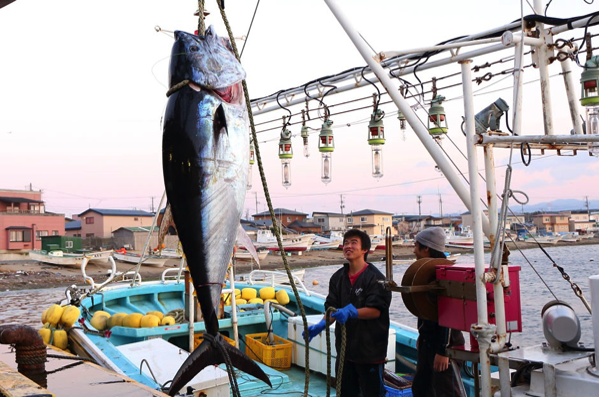
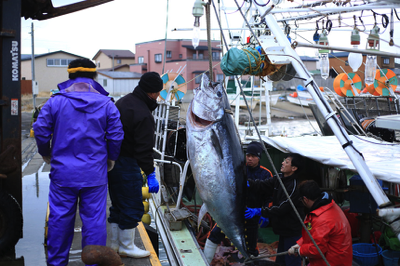
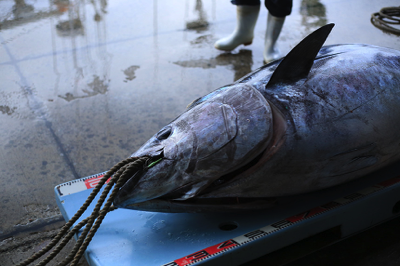
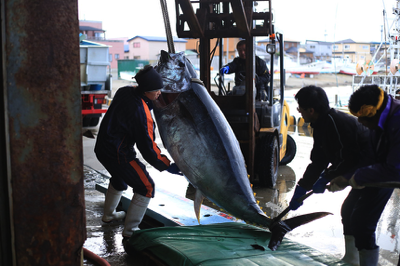
Oma Maguro Tuna
Oma Tuna is Pacific Bluefin tuna (kuro-maguro or hon-maguro in Japanese), and it is also known as “black diamonds.” Tuna caught in the Tsugaru Strait is wild bluefin tuna, which are typically larger than other tuna, weighing 200 to 300 kg. Specifically, tuna caught in Oma is top quality, and known across the country by the brand name “Oma Tuna (Oma Maguro in Japanese).”
In 2007, Oma Tuna was made into a regional collective trademark, a product of the Oma Fisheries Cooperative. Every tuna shipped out of Oma that weighs over 30kg proudly displays on its cheek an Oma Tuna seal to represent the brand. The stickers are tightly managed, with a serial number indicating which boat caught the tuna, when the tuna was caught, and the method used to catch it.
The Open Sea around Oma is the Ideal Tuna Fishing Grounds
Oma Tuna is caught in an area of open sea located 5km off the coast of Cape Oma. This area is said to have a geographical indentation that is a path frequented by tuna. Oma faces the Tsugaru Strait, the channel joining the Japan Sea with the Pacific Ocean. Three currents converge at this point: the Kuroshio Current, Tsushima Current, and Chishima Current. As a result, a lot of plankton live in the area. This high-quality plankton feeds squid Pacific saury, which are the tuna’s favourite food. This attracts tuna to the area.
There are two separate groups of bluefin tuna found in the Tsugaru Strait. One travels to Aomori in the Tsushima warm current, which climbs up the Sea of Japan side to the Tsugaru Strait. The other group rides in the Kuroshio Current from the Pacific Ocean side. Every year from August to January, the tuna that swim around the Japanese islands come to the Tsugaru Strait from both the Japan Sea and the Pacific Ocean. The temperatures in the strait are extremely cold during the fall and winter months so the tuna that can be caught there are top-class tuna that are particularly large, carrying high quality fat all over their bodies.
The Battle against Giant Tuna, Using 2mm Diameter Fishing Lines
Tuna pole fishing is traditional fishing method that has been practiced for over 100 years. It is a truly astonishing fishing method that uses fishing lines about 2mm in diameter to catch enormous tuna. In the sea around Oma, pole fishing is carried out in the daytime, and a separate fishing method called longline fishing is performed at nighttime. Both methods differ from net fishing and other methods used to capture large numbers of fish at once. The line fishing methods allow for capture of tuna without injuring them so the tuna are in good condition when being drained of blood and preserved, keeping the tuna very fresh as they await shipment. In order to raise the quality of the tuna by even just a fraction, it is important to prevent “burning.”Specifically, “When the tuna gets caught, it fights to escape. And when it does, its temperatures rise up to 40 degrees Celsius, ‘burning’ the meat. The meat turns pink and tastes tough. If this happens, you can’t get a good price for it at the market.”
Painstaking methods are also taken to process the tuna on the boat in order to retain its freshness. Immediately after the tuna is caught, it is gutted and the gills and tail fin are removed. It is then washed with salt water and placed in ice water. The degree of freshness will differ completely depending on whether this process is carried out or not.
In recent years, some fishermen have begun to use electric shockers to temporarily stun tuna as they are reeled in close to the boats. They can then haul the motionless fish on board. This technique reduces the number of tuna that are lost, as many struggle so hard on the fishing line that they manage to escape, and it allows fishermen to ship out tuna while maximizing the value of each one, preserving the natural resource that is Oma Tuna.
Japan's king of tuna
The well-known “Oma Tuna” comes from the Tsugaru Strait. and is known as the black diamond because of its record-breaking selling prices in the Tsukiji Market’s first auction of the year.
Tuna is a favourite food of Japanese. This lean fish is popular both in sushi and as sashimi. Tuna range over a wide territory in the waters around Japan—they’re caught off Shizuoka, Tokyo, and Okinawa—but tuna caught near Oma at the tip of the Shimokita peninsula in Aomori represent the pinnacle of Japanese tuna. A single tuna reached a record high of 55.4 million yen (approx. USD 1.76 million) at Tokyo’s Tsukiji fish market! Confidence in Oma tuna is overwhelming. In the 2001 first auction of Tsukiji Market, a 202-kg (445 lbs) tuna was sold for an astounding price of over two million yen. Since then, Oma Tuna has continued to break the record. In 2019, one Oma Tuna was sold for 333.6 million yen, the highest price for fish sold in an auction in history. This has given the Oma Tuna the nickname of “black diamond.”
Japan’s top tuna highlights country’s recovery from Covid-19
The IUCN Red List of Threatened Species shows Pacific bluefin tuna (Thunnus orientalis) as “vulnerable”— one step better than “endangered.” But rarity isn’t the reason one bluefin sold for JPY 193.2 million (USD 1.8 million, EUR 1.6 million) at the first sale of the new year at Tokyo’s Toyosu Market on 5 January.
The price – the second-highest on record after last year’s JPY 333.6 million (USD 3.1 million, EUR 2.7 million) sale – is all about generating buzz in the media to gain name recognition, a public relations stunt that is common in Japan. The winning bidder, Kiyoshi Kimura, president of Tokyo-based restaurant chain Sushi Zanmai, has used the event to get his company’s name in the news worldwide for several years.
The tuna, caught near Oma, in Aomori Prefecture, weighed 276 kilograms, and sold at JPY 700,000 (USD 6,418 or EUR 5,771) per kilogram. Following the purchase, the fish starred in a tuna-cutting show at Sushizanmai’s headquarters in Tsukiji, Tokyo, and o-toro (fatty), chu-toro (medium fatty), and akami (lean) sections were set out for display. The shop will naturally take a huge loss on the sales, and the purchase is more akin to a U.S. company airing a television commercial during the Super Bowl than to purchasing food ingredients.
The first auction of the year is claimed to be an indicator of the economy for the coming year, though advertising luxury items (snow crab, for example) at outrageous prices is a commonly-used method in Japan to build product image.

